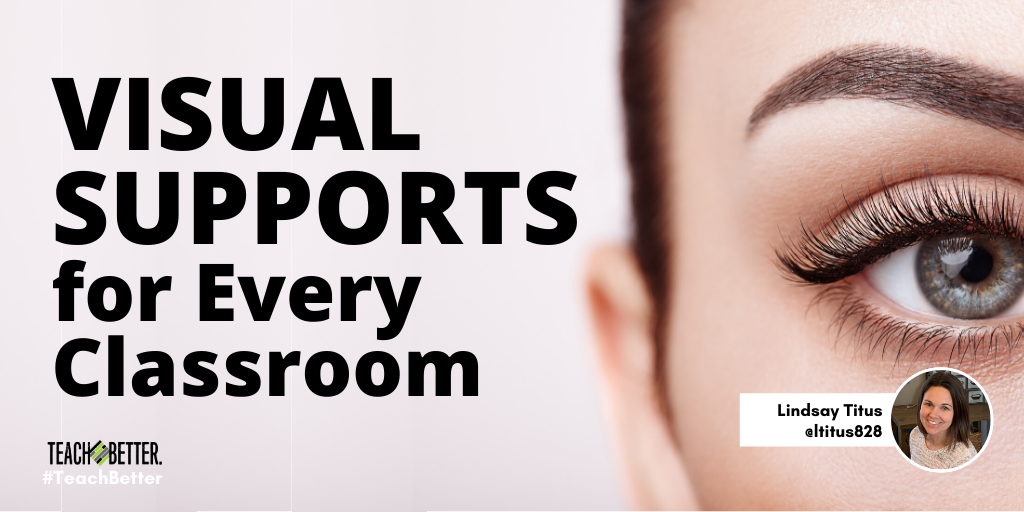TL;DR:
- Agendas, contingency maps, and signs are some visual supports to help learners become independent.
- Decide how to incorporate visuals in your classroom by considering a number of anchoring questions such as: What is the expectation? What needs to be done right now? What is coming next?
- This post includes links to 3 PDF visuals to use in your classroom.
One of the best pieces of advice I received from a mentor was, “when you find yourself sounding like a broken record, write it down!” This advice may be the very reason I love visuals as much as I do. I believe that visual supports are essential to any classroom. Often, I find that visuals are recommended for specific classroom types; however, I encourage all teachers to incorporate functional visuals into their classroom environment—regardless of student age, level, or content.
Simply put, visuals are essential. Visuals are a tool and a vehicle to help bridge the gap from learners that are dependent on adults to independent learners. These simple tools can help children self-monitor, become self-aware, and empower them to take control of their learning.
Visuals help students because they provide for guidance without the requirement of an adult to be right there for support. They can help to bridge the gap between “I don’t know what to do” and “I know what step I can take first.”
As adults, we use visuals every day—whether it is referencing a to-do list, using a recipe, reading instructions, or reading the road signs while driving. Visuals take auditory information and make it visual. Simple as that! So many adults crave visual stimulation, and our students do too!
Visuals are a tool and a vehicle to help bridge the gap from learners that are dependent on adults to independent learners. Click To TweetAnchoring Questions to Use with Visuals
- What is the expectation? What needs to be done right now?
- When will I be done with this activity? How will I know when I am done?
- How much of this task am I doing?
- What is coming next?
The question I receive most often when it comes to visuals is, “do I need a visual for everything?” The answer is no. To which the second question becomes, “then when do I use visuals?”
Getting Started
Create a visual if…
- You are repeating the same direction or instruction.
- You are looking to increase student independence and self-monitoring.
- You want the student to have access to the information to reference at another time.
Visuals can quickly become overwhelming or another thing to do. Therefore, I like to use visual templates and use the same template for multiple uses in the classroom.
Here are my favorite visual templates.
Daily Agenda + Mini Agenda
Many teachers have a class schedule hanging on the front board. This is a great first step and will be sufficient for most of your students. Notice that is most, but not all. You may find that 1 or 2—sometimes more, sometimes fewer—of your students need an individualized schedule they can have access to all day. Sometimes students need a larger class topic broken down into easy tasks, which is a great way to use this class schedule and mini agenda template.
Contingency Map
Students engage in behavior to solve a problem. A major part of my role as a behavior specialist is to coach students and staff on why a person is engaging in a behavior. Although we may initially think the behavior is the problem, I have learned that the behavior is the solution to a problem.
This contingency map helps to visualize the current pathway a student is taking to solve their problem. The second part of the chart will then be a teaching tool to showcase to the student another path they could take that will solve the same problem in an easier, more efficient, expected way!
Change Sign
Everyone has probably experienced this at one point or another: You tell your students in the morning about a change happening later in the day. They seem okay with it and they keep moving throughout the day. Yet when the change happens, they act like it is the first time they are hearing the information.
It used to happen to me all the time! I would think to myself, “I know I told them about this, so what happened?” Well, in all honesty, life happened! They heard you, but many probably did not process what you had said or realized the impact it would later have.
An easy way to help students with this is to use a change sign! The best part is that it is remarkably simple. All you need is the word CHANGE on an index card or some other card that you can put on your classroom schedule. Simply put the word CHANGE over the activity when the change is occurring, and write next to it what is really happening on your schedule. The addition of the word sign helps to signal to students what change is, what is going to happen, and provides an opportunity for students to process this change throughout the day.
[scroll down to keep reading]Keep it Simple!
Visuals are a tool to help bridge the gap for students. As educators we can use visuals to reduce the students depending on us for information. Instead we can use visuals as a tool to increase confidence in their own learning! When starting out with visuals, keep it simple. Less is absolutely more when it comes to these types of tools. Keep it functional, and keep it purposeful to the student and the activity!
About Lindsay Titus
Lindsay Titus is a K-12 Behavior Specialist with a license in behavior analyst. As a Board Certified Behavior Analyst, Lindsay coaches and trains educators on the study of behavior and how to implement evidence based behavior principles in simple and easy ways! With experience as a classroom special education teacher, and behavior specialist in public schools, residential placement, and private settings, Lindsay enjoys working with all educators looking to reignite their passion for education, connect with all students, and conquer challenging behavior in any classroom setting.




